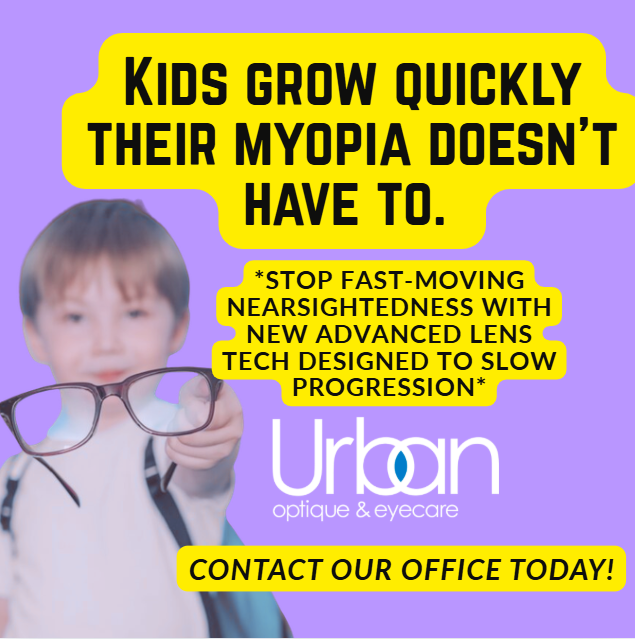
Preserving Comfortable, Healthy Sight
Eye care is more than assessing your eyeglass or contact lens prescription. We evaluate eye health to help ensure your vision is comfortable and functioning healthily. Diagnosing and managing eye problems is crucial to our mission—providing patients with effective, personalized eye care through every stage of life.
We can also diagnose conditions with ocular symptoms, like diabetes, autoimmune disorders, high blood pressure, and vascular disease. We can see a lot with comprehensive care, and we aim to use all the knowledge, experience, and technology at our disposal to serve you and your family.
Book regular eye exams at Urban Optique & Eyecare so we can keep on eye on your eye health needs.
Book Appointment
Diagnosing Eye Health

Your vision relies on a complex system, from your eyes to your brain. And every part is essential for healthy, comfortable vision. When you visit us for a comprehensive eye exam, we look at more than the color of your eyes—although the iris is crucial for focusing light! We use specialty technology to see your eye in detail, inside and outside.
Diagnostic technology helps us evaluate your current eye health and predict changes. We use what we learn about your vision and eye health to personalize your care, from assessing risks to determining treatment plans.
Visiting us for regular eye exams gives us more information about how your eyes change over time, so we can monitor even the smallest of concerns.

Common Eye Diseases & Conditions
There are many eye diseases and conditions we can diagnose and help manage, from the common to the uncommon. Some eye problems are preventable or treatable, while others have symptoms we can help alleviate or improve. Early detection offers patients the best chance of safeguarding their sight in all cases.
We aim to educate our patients, so they can make informed decisions about their eye care. Learning about common eye diseases & conditions is one small part of helping our patients learn about their vision.
Cataracts
A cataract is a cloudy or opaque spot on the eye’s clear lens. The flexible lens changes shape to help focus light inside the eye, stretching or shrinking for seeing different distances.
When proteins in the lens break down, they clump together—forming a cataract—and reducing the lens’ flexibility. As a result, people with cataracts experience gradually decreasing vision at all distances.
Many people develop cataracts over age 55, as the lens can become more rigid, resulting from natural aging. However, lifestyle factors and health conditions can contribute to development, including smoking, excessive alcohol consumption, and UV exposure.
Urban Optique & Eyecare offers glaucoma testing. Early detection is crucial to saving sight, as cataracts are a leading cause of low vision and blindness in the US.
Conjunctivitis (Pink Eye)
Conjunctivitis (pink eye) is the inflammation of the conjunctiva, the clear covering of the eye and inner eyelids. The thin layer protects the eye from infection and debris. Tiny blood vessels in the conjunctiva expand when the tissue is irritated, making the eye appear pink or red.
Conjunctivitis can be infectious or noninfectious:
- Allergic and chemical conjunctivitis are noninfectious.
- Bacterial and viral conjunctivitis are highly contagious.
Treatment depends on the type and the eye’s reaction. For example, a person may have a mild reaction to allergies, easily treated with allergy medication. Or they may have a severe allergic reaction, increasing the risk of severe symptoms.
Optometrists can prescribe or recommend appropriate treatment after evaluating your eye health. Receiving treatment for pink eye can improve eye comfort and reduce the risk of complications.
Dry Eye
Dry eye or dry eye disease is a common, chronic eye problem caused by poor tear production. Tears (the tear film) help moisten and nourish the eye’s surface. The tear film has 3 layers:
- The oily outer layer prevents tears from drying too quickly & makes the eye’s surface smooth
- The watery middle layer moistens the eye & delivers nutrients to the eye’s surface
- The inner mucus layer helps tears stick to the eye’s surface & spread evenly
When one of the layers is lacking, tears are of poor quality. For example, meibomian gland dysfunction causes evaporative dry eye (tears dry up too quickly). The meibomian glands produce the oily layer of tears.
People with dry eye can experience various uncomfortable symptoms. It can also increase the risk of repeat infections, leading to corneal scarring and impaired vision.
Symptoms may include:
- Blurry vision
- Burning or stinging
- A gritty or scratchy sensation
- Light sensitivity
- Redness
- Watery eyes
We can create a customized treatment plan to help alleviate symptoms and support tear production. When you have dry eyes, book an appointment for dry eye therapy.
Glaucoma
Glaucoma causes progressive optic nerve damage. The optic nerve is a bundle of over one million nerve fibers at the back of the eye. The nerve fibers send visual information (as electric signals) from the retina to the brain. When nerve fibers are lost, vision is lost. Over time, glaucoma leads to significant optic nerve damage, resulting in blindness.
There are many forms of glaucoma, but the most common in the US is open-angle glaucoma. Excess fluid in the eye increases pressure on the optic damage, slowly causing the nerve fibers to deteriorate.
As open-angle glaucoma develops slowly, many people notice no symptoms until significant damage occurs. In time, people with glaucoma may see peripheral vision loss. Unfortunately, optic nerve damage cannot be reversed. However, early detection can help prevent further vision loss.
At Urban Optique & Eyecare, glaucoma screening is a routine part of our comprehensive eye exams.
Keratoconus
Keratoconus is a vision disorder occurring when the normally dome-shaped cornea (clear front of the eye) thins and bulges. The irregular shape prevents light from entering the eye effectively, resulting in distorted vision.
Keratoconus is generally uncommon, with prevalence estimates ranging from approximately 1 in 2,000 individuals or as high as 1 in 400 individuals. People are more likely to develop the condition if a close relative suffers from the disorder. Another risk factor is frequent, aggressive eye rubbing.
In the early stages, glasses or contact lenses can help improve vision. However, patients may need customized specialty lenses, as standard lenses may be incompatible with the irregular cornea. When the disease progresses, corneal cross-linking surgery can help strengthen the cornea to slow progression.
Macular Degeneration
Macular degeneration is an eye disease affecting the macula (the oval-shaped center of the retina). The macula helps us see central vision, fine details, and color. Macula deterioration causes distorted lines or details, dim color vision, and a blank or dark spot in central vision.
There are 2 forms of the disease:
- Dry (atrophic) is the most common form. Macula tissue thins, preventing the macula from working effectively. There is no cure, but diet and nutrition can help prevent progression.
- Wet (exudative) is rarer but can develop rapidly with severe symptoms. Fluids leak from abnormal or weakened retinal blood vessels, blurring central vision. When detected early, treatment can seal or remove leaky blood vessels to help improve vision or prevent worsening symptoms.
The disease is commonly referred to as age-related macular degeneration because it’s more common in adults over 55. However, other risk factors can contribute to the disease’s development, including:
- Poor nutrition
- Lack of exercise
- Smoking
- UV light exposure
People experiencing the early stages of dry macular degeneration may have no symptoms. But wet macular degeneration can show sudden symptoms, causing an eye care emergency. Early detection is crucial to preventing the disease’s progression and vision impairment.
Retinal Detachment
Retinal detachment is when the retina tears or detaches from the back of the eye. The retina is thin, light-detecting tissue essential for capturing images. Unfortunately, the retina is delicate and can weaken or dislodge because of disease or injury.
For example, high myopia (nearsightedness) is caused by eye growth. As the eye elongates, it stretches eye tissue, including the retina. Over time, the weakened retina can deteriorate or detach. Managing myopia can help slow eye growth in children to reduce the risk of retinal detachment.
When the retina pulls from the back of the eye, some patients see a dark shadow or curtain fall over their eyes. Other symptoms can include:
- Increased floaters & spots
- Seeing flashes of light
- Vision loss
Retinal reattachment surgery is successful for 90% of patients. Seeing an optometrist for an evaluation and treatment as soon as possible can help save your sight.

Stay Informed About Your Eyes
Routine comprehensive eye exams are crucial for detecting and managing eye diseases. We can personalize your eye care, so you know your risks and what you can do to help prevent eye problems.
Visit Urban Optique & Eyecare for eye exams and individualized care.
See More with Optomap Retinal Exams
At Urban Optique & Eyecare, we are proud to offer specialty technology for effective, and efficient eye care services.
We offer the Optomap retinal exam as an important part of our eye exams. Optomap produces an image that is as unique as your fingerprint and provides your doctor with valuable insight into your eyes.
Optomap allows us to see over 80% of your retina, which means we can get more information about the health of your eyes. And because many eye conditions can develop without symptoms, Optomap is a great tool in the detection and prevention of long-term vision and ocular damage.

Our Brands













Our Location
Our Address
- 4960 S. Gilbert Road, Suite 11
- Chandler, AZ 85249
Contact Information
- Phone: 480-802-7170
- Fax: 480-802-3812
- Email: [email protected]
Our Hours
- Monday: 9:00 AM – 5:30 PM
- Tuesday: 9:00 AM – 5:30 PM
- Wednesday: Closed
- Thursday: 9:00 AM – 5:30 PM
- Friday: 9:00 AM – 5:30 PM
- Saturday: 9:00 AM – 1:30 PM
- Sunday: Closed
Closed for Lunch Monday-Friday: 1:30-2:00
Book Appointment
Our Google Reviews
Check us out on Instagram
Error: No feed found.
Please go to the Instagram Feed settings page to create a feed.









